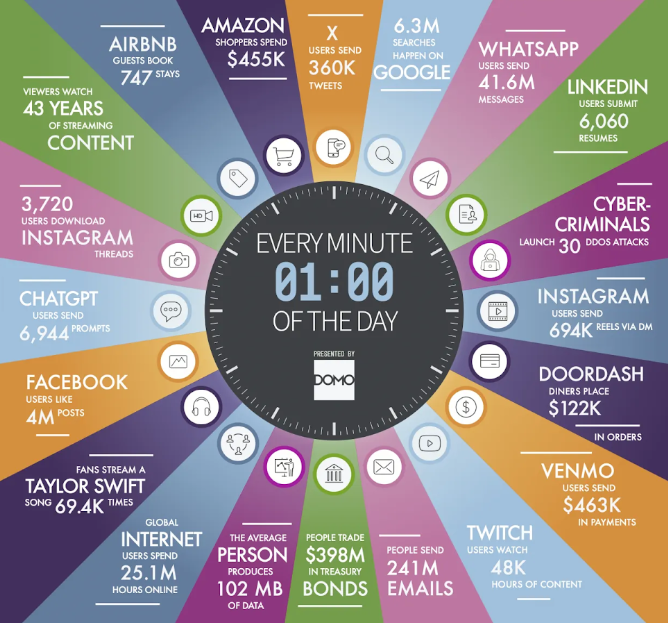By our Chief Operations Officer Florencia Cattelani
When we talk about artificial intelligence, better known as #AI, we refer to the ability of machines or computer systems to perform tasks that would normally require human intervention, such as pattern recognition, problem solving, decision making and understanding natural language. How do they do this? Through complex algorithms and mathematical models that allow machines to process large amounts of data and learn from it to improve their performance in a variety of tasks. From virtual assistants to medical diagnoses, AI is increasingly present in virtually all areas of our daily lives. In this process, data plays a key role. I like to think of data as the “fuel” that drives the learning and operation of artificial intelligence systems. Some of its main uses include:
Model training: in many AI approaches, machine learning algorithms are used that require large amounts of data to train models. These models learn patterns and relationships in the data by analysing labelled and unlabelled examples. The more quality data used to train the model, the better it generally performs.
- Validation and evaluation: Data is also used to validate and evaluate the accuracy and effectiveness of trained AI models. Test data sets are used to measure how a trained model performs on previously unseen data.
- Continuous improvement: Once an AI model is in production, data collected in real-time can be used to feed back into the model and improve its performance over time. This process is known as online learning or active learning.
- Bias detection and data cleaning: Data may contain inherent biases that can negatively affect the performance and fairness of AI models. It is important to conduct thorough data analysis to detect and mitigate any biases, as well as to clean the data to ensure its quality and relevance.
- Personalisation and recommendations: User behaviour data can be used to personalise experiences and provide relevant recommendations. This is commonly seen in recommendation systems for movies, music, products, etc.
Nowadays the amount of data generated has grown exponentially. We focus so much on data, collect it, make decisions based on it, but… how do we manage it?

Today the focus is not on data collection, but on how we consolidate data to make use of it.
The problem of data consolidation refers to the task of combining and organising scattered and possibly heterogeneous data from multiple sources into a single coherent and unified data source. This process is crucial in many contexts, especially in the business environment, where organisations often have data stored in different systems, databases or even in different formats.
Some of the challenges associated with data consolidation include:
- Data integration: data sources may use different data schemas, formats and naming conventions. Integrating this data requires mapping and transforming the data so that they are consistent and compatible with each other.
- Data quality: Data from different sources may have inconsistencies, errors or duplicates. It is important to perform a data cleansing process to ensure that the consolidated information is accurate and reliable.
- Security and privacy: When consolidating data from multiple sources, it is crucial to ensure the security and privacy of the information, especially if sensitive or confidential data is involved.
- Volume and scalability: Handling large volumes of data and ensuring system scalability are major challenges in data consolidation, especially as organisations grow and generate more information.
- Continuous updating: Data is dynamic and subject to change over time. It is important to consider the need to update and maintain consolidated data on an ongoing basis to reflect changes in the original data sources.
So far we can say that artificial intelligence will only be as good as the quality of data it is based on, but how can we help companies organize, classify and clean their data so that it is a good input into their artificial intelligence systems?
Salesforce created Data Cloud for this purpose. Data Cloud is deeply integrated with the entire Salesforce ecosystem. So you don’t need to organize all your data in one place and then figure out how to use it to interact with customers. #DataCloud makes it very easy to bring all of your Salesforce data together, whether it’s from multiple clouds or multiple orgs. And all that data is unified and harmonized in a single space that all applications can access.
Data Cloud unifies all the data from all the different and disparate systems, not just the different Salesforce clouds. In fact, 75% of the data in Data Cloud comes from outside Salesforce today. This means website data, telemetry data, and structured or unstructured data. You can easily get data with connectors and connect to big data providers in a secure and compliant way from external data platforms like Snowflake, Google, AWS and Databricks to share data and train AI models.
But if we talk about integration, it is appropriate to also talk about MuleSoft. MuleSoft remains a key player in integrating and accelerating the use of artificial intelligence.
The complexity of today’s AI continues to grow. Companies have on average around 1000 different applications and are in a race to differentiate themselves from their competitors. They are increasingly obliged to deliver high quality digital experiences and must also become more efficient to keep up.
The numbers are enlightening – 49% of the world’s population has already had some interaction with artificial intelligence and 86% of IT leaders consider AI as a necessity for the near future**.
It is clear that artificial intelligence is on the rise, but there are still some barriers to its mass use within organizations. The three most prominent are integration, security and privacy.
As I mentioned earlier, AI is only as powerful as its data. Data integration is a key part of its success. Integration remains a top priority for implementing a digital transformation strategy as new technologies emerge and create greater challenges.
Strong work must be done to integrate systems and data to pave the way for artificial intelligence. Otherwise, this shortcoming will prevent us from getting the most out of AI, significantly improving the daily lives of employees and customers.
In addition to integration, automation is another technology that resonates strongly in this era. A recent report shows that automation is saving an average of 1.9 hours per week***. In addition to efficiency, we can focus our teams on more strategic tasks, leaving the routine to so-called bots.
While MuleSoft remains synonymous of integration, it is worth noting that it is much more than that. MuleSoft has a number of tools that can span different use cases, facilitating integration, API management, offering RPA (Robotic Process Automation) capabilities and being a key part of AI implementation.
Regardless of the tool of choice, today we are forced to make data processing and data consolidation/integration a top priority for IT teams. Those who do not make intelligent use of their data will be at a competitive disadvantage. Today, we have seen the power shift from supply to demand. Consumers are becoming more demanding and we have to keep up.
(**) Source: “2024 Connectivity Benchmark Report.”, MuleSoft, 2024
(***) Source: “Automation: Trends, Challenges and Best Practices,” IDC Info Brief sponsored by Salesforce, March 2023. IDC #US50410923.
